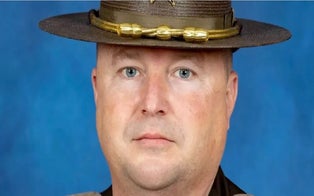Deborah Norville traveled to the Frontier Airlines training center to find out what it takes to be a flight attendant in the post 9/11 world. She was preparing to take on the job of a flight attendant during a Frontier Airlines flight from Denver to Ne
Most people think they know what it takes to be a flight attendant. But as it turns out, it's a lot more difficult than it looks.
In this post 9/11 world, being a flight attendant is a demanding job, as INSIDE EDITION's Deborah Norville discovered at the Frontier Airlines training center.
Lesson one for flight attendant trainees? Self defense. Norville learned how to subdue an unruly passenger by aiming for the throat and nose.
Next she learned how to alert people she is in distress and call for help. If a passenger has to be restrained, tape is a critical tool for a flight attendant.
She was also prepared for the worst scenario: She learned the precise commands used during an emergency landing.
If all the training to become a flight attendant these days seems deadly serious, it is. 90 per cent of the training focuses on safety.
"When prospective flight attendants come in, are they surprised at how complicated the job is?" Norville asked in-flight instructor Chris Basore.
"Absolutely. I think they're surprised that we're two weeks into the training and we haven't really talked about the beverage cart yet," said Basore.
Norville eventually got a quick lesson in the food and beverage service too. It was simplified by the fact that every cart on all Frontier flight is arranged in the same way.
INSIDE EDITION's anchor went to flight attendant training because she was going to be working a real Frontier flight, the 3:10 p.m. from Denver to New York City.
Her duties began with helping passengers stow their baggage, and she says her packing skills quickly kicked in. Then it was time for the safety announcement, and despite a few bumps, Norville quickly recovered.
When it was time for beverage service, she found out serving drinks, picking up trash, and serving more drinks really is hard work. Norville says at the end, she felt very grateful her passengers were good sports.
She says as they thanked her, she was grateful they didn't get to see the bulk of what flight attendants can really do.
12 per cent of students don't make it through flight attendant training. One thing Deborah Norville learned is that 80 per cent of the people who read the safety information card in the seatback survive in the event of an emergency.






